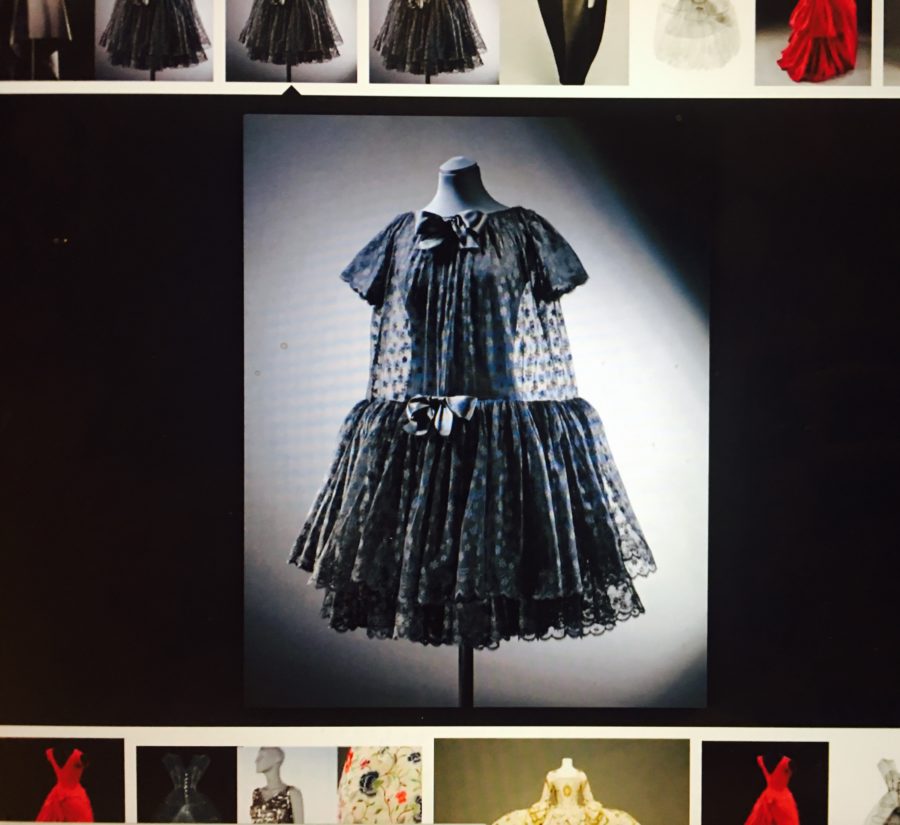The Victoria & Albert Museum puts on a major fashion-related exhibition every year. This year’s show, Balenciaga: Shaping Fashion, celebrates the 100th anniversary opening of Balenciaga’s first dressmaking shop in San Sebastian, Spain and the 80th anniversary opening of his haute couture house in Paris, France. The exhibition showcases some 120 outfits and accessories, with the majority of the collection from Balenciaga’s 1950s and ‘60s-era.
The exhibition is housed in a cosy two level space within the V&A. On the ground floor, visitors are led in a counter-clockwise direction between themed window displays of exquisite Balenciaga designs. Each row of display focuses on Balenciaga’s innovations in the female silhouette, broken down into the fundamental elements of modern ‘dress’, including cut, fabric, form, and embellishments.
Balenciaga’s pioneering interpretation of the modern female silhouette was characterized by simplistic straight lines, bulky volume at the back, and obliteration of the waistlines which resulted in the abstraction of the body. For example, the trapeze-shaped volume in his ‘baby doll’ dress blurred the contours of the body. It was surprising to learn that this loose-fitted design was highly controversial at the time, considering how the ‘baby doll’ dress is now so widely adopted and replicated today. If I remember correctly, the baby doll is part of the basic-wear line of Zara and H&M.
Balenciaga’s later designs of the 1960s and ‘70s are characterized by the increasingly architectural shapes in his garments, such as the flared lantern sleeves. Balenciaga worked closely with fabric manufactures, like the Swiss company, Abraham, to produce innovative fabrics such as the lightweight ‘gazar’ silk which could hold the elaborate shapes without cumbersome supportive structures inside.

Finally, the ground floor ends with some of Balenciaga’s most iconic designs such as the ‘unsexy sack’ which eradicated a pinched waist altogether, the ‘semi-fit dress’ which was only fitted in the front but loose in the back, and the three-quarter bracelet sleeve jacket with the stand-away collars which allowed for the display of jewellery at the neck and wrists. These designs contrasted sharply with the dominant, and conventional, waist-hugging, hourglass shape favoured by his contemporary competitors.
Heading upstairs, visitors are welcomed into a high-ceiling, well-lit room. Unlike the first half of the exhibition, which highlighted Balenciaga’s experiment in silhouette, his skills and ingenious designs, the second half focuses on Balenciaga’s legacy and the vast array of designers he has influenced.
We see from the displays that Balenciaga’s commitment to minimalism has been adopted by designers such as Emanuel Ungaro, Rick Owens, and J.W Anderson. Balenciaga’s emphasis on shape and volume that stood away from body has influenced the likes of Molly Goddard, and Rei Kawakubo. Balenciaga’s innovative pattern cutting and adoption of new materials has influenced designers like Issey Miyake, McQueen, Alaia, and a whole wave of designers who came after him. Like Christian Dior once said, ““Haute Couture is like an orchestra whose conductor is Balenciaga. We other couturiers are the musicians and we follow the direction he gives.”

Today, Balenciaga is known more for its streetwear-inspired, knitted, high-top sneakers and oversized hoodies, than for its radically abstracted haute couture dress designs. The V&A exhibition serves as a worthy reminder that it was Balenciaga who laid the foundations for many of the basic dress designs in the western wardrobe that we may take for granted today.
All images author’s own
By Lily Mu


